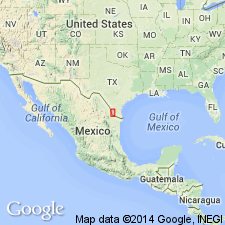
- Usage in publication:
-
- Agua Verde shale member
- Modifications:
-
- Original reference
- Dominant lithology:
-
- Shale
- AAPG geologic province:
-
- Gulf Coast basin
Summary:
Pg. 269-270. Agua Verde shale member of Fayette formation. Proposed for marine shales overlying Sanchez sandstone tongue [in upper part of Fayette formation]. Shales are 150 feet thick, mostly gray green, and bentonitic but contain some red nonmarine beds in upper part. Underlies Villa Nueva sandstone member of Fayette. In southern Zapata County, southern Texas, the shales appear to be overlapped by the Frio, or may, in part, grade into nonmarine shales that resemble Frio. Area in which Agua Verde shale crops out is limited, and beds are poorly exposed because of heavy overburden. Age is Eocene.
[Type locality not designated.] Named from Agua Verde ranch house on north line of Escobares quadrangle, [Zapata Co.], southern TX. "...In the first creek that crosses the north-south road, 1 mi due south of this ranch house, the top of the Sanchez sandstone is exposed. A short distance east, in tributary gullies, the basal marine Agua Verde shales containing TEXTULARIA HOCKLEYENSIS and other Foraminifera may be found..."
Source: US geologic names lexicon (USGS Bull. 1200, p. 28); GNU records (USGS DDS-6; Denver GNULEX).
For more information, please contact Nancy Stamm, Geologic Names Committee Secretary.
Asterisk (*) indicates published by U.S. Geological Survey authors.
"No current usage" (†) implies that a name has been abandoned or has fallen into disuse. Former usage and, if known, replacement name given in parentheses ( ).
Slash (/) indicates name conflicts with nomenclatural guidelines (CSN, 1933; ACSN, 1961, 1970; NACSN, 1983, 2005, 2021). May be explained within brackets ([ ]).

